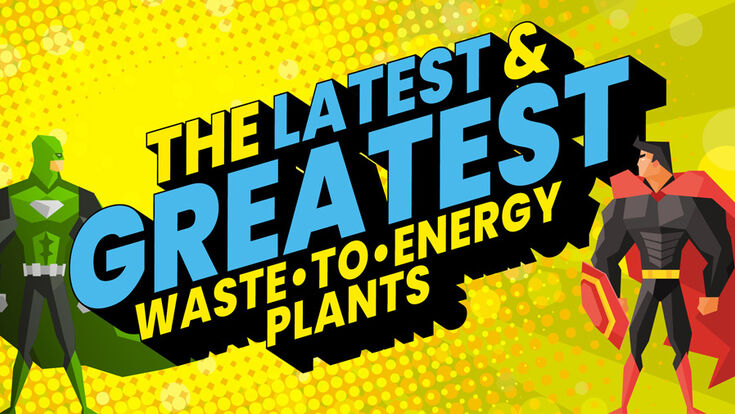Waste-to-energy : The top waste-to-energy plants 2022

Active membership needed
Register now and become a WEKA PRIME member

- Rankings & analyzes from all industries
- All WEKA PRIME content of 12 online-magazines
- 1 E-Paper annual subscription of your choice
- E-Paper in your inbox a week earlier
Norway: Hafslund Oslo Celsio plant
Oslo, Norway
The Klemetsrud plant owned and operated by Celsio treats 365,000 tonnes of residual waste from the Oslo area. It is Norway’s largest WtE facility, producing 152 GWh of electricity and 835 GWh of district heating per year. Hafslund Oslo Celsio will be connected to it and so will become the first full-scale carbon capture and storage (CCS) WtE plant in Europe in 2026. The CCS plant will capture 400,000 tonnes of CO2 when running (90 per cent of the plant’s emissions) for permanent geological storage below the seabed. The technology is supplied by EPC contractor Technip Energies.
As around half the waste is of biological origin, the plant will even be carbon negative, capturing and storing both fossil and biogenic CO2.
Italy: Brescia WtE plant
Brescia, Italy
Active since 1998 and run by A2A, the plant provides 70 per cent of the energy distributed by district heating (900 GWh of heat produced in one year) as well as producing electricity equal to the needs of 200,000 families (600 GWh of electricity produced in one year). It treats around 730,000 tonnes of residual waste per year.
The next major improvements and upgrades in the plant will be flue gas condensation and heat pumps for further heat recovery and hydrogen production. It will receive EU funding for the latter.
Discover now
- Reading
-
Videos
- Eldan at IFAT 2024 Dec 6, 2024
- Cesaro Mac Import and Tiger Depack at IFAT 2024 Dec 6, 2024
- Panizzolo at IFAT 2024 Dec 6, 2024
The Netherlands: Duiven WtE plant
Duiven, the Netherlands
Since 2019, the WtE plant run by Dutch waste-to-energy company AVR has been linked to a carbon capture unit, which captures up to 100,000 tonnes of CO2 per year. This is reused in greenhouses for the cultivation of flowers, vegetables and other plants.
Belgium: Ecluse project
Antwerp, Belgium
ECLUSE is an alliance between Indaver, SLECO, Fluvius, FINEG, Maatschappij Linkerscheldeoever and Water-Link. The Ecluse project in the port of Antwerp treats 1 million tonnes of waste per year. The WtE plant delivers steam to nearby industry through the largest industrial steam network in Europe. Since 2019, it has enabled 100,000 tonnes of CO2 to be saved per year for the industry connected to the network, and could also be extended to other companies, resulting in up to 200,000 tonnes of savings. The project will also supply at least 5 per cent of all the green heat produced in Flanders. The project won CEWEP’s Integration Award in 2018.
USA: Palm Beach County Renewable Energy Facility
Palm Beach, Florida, USA
The Palm Beach County Renewable Energy Facility No. 2 is a 3,000-tonne-per-day plant, built in 2015, which is owned by the Solid Waste Authority of Palm Beach County and operated by Covanta. It is the best-performing facility in North America from an environmental standpoint and is currently exploring WtE ash reuse options to further reduce its landfill tonnages.
Japan: Saga City WtE plant
Kyushu Island, Japan
The Toshiba-built plant was the world’s first attempt to capture CO2 emissions at a waste-to-energy plant for reuse on a commercial scale.
Following the success of the test plant, the CCU plant entered commercial operation in 2016. The facility captures up to 10 tonnes of CO2 from the plant’s flue gas, which is then piped to a nearby glass-covered algae farm. From there, and using proprietary technology, the CO2 is utilised to produce high-end lotions and creams.
USA: Honolulu Resource Recovery Veture – H-POWER
Kapolei, Hawaii, USA
The Honolulu facility is a 3,000-tonne-per-day energy system consisting of a 2,100 tpd refuse-derived fuel plant built in 1990 and a 900 tpd mass burn plant added in 2012. The system is owned by Honolulu and operated by Covanta. H-POWER landfills about 150,000 tonnes of ash per year. The city awarded Covanta a project, which is in the early stages, that involves extracting clean aggregate from the ash and reducing between 60 and 80 per cent of the landfilled ash. The success of this venture could potentially boost the city’s already high 82 per cent landfill diversion rate to more than 90 per cent, which would rank it among the top cities in the country.
China: Bao’an waste-to-energy plant
Shenzhen, China
The plant was constructed in three phases using technology from Keppel Seghers. The first phase was also the first WtE plant in China. The second phase was recently awarded the gold medal for national engineering. The last phase consists of five lanes, each of which treats 1,000 tonnes per day.
Together, the three phases are the largest WtE plant in the world, treating almost 9,000 tonnes of waste per day and producing 200 MW of electricity on one single site. All in all, three million tonnes of waste are treated annually, producing electricity for one million people.
Singapore: TuasOne
Tuas, Singapore
Singapore’s sixth WtE plant commenced initial operations in December 2021 and has been steadily increasing its operating capacity ever since. It can now incinerate 3,600 tonnes of waste and generate 120 MW of electricity daily. Operated by Mitsubishi Heavy Industries Environmental & Chemical Engineering ECO Creation Singapore Co. Ltd (MHIEC ECO Creation), the facility is located on 4.8 hectares of land. TuasOne is the most land-efficient WtE plant in Singapore to date. The energy generated at the plant is enough to meet the electricity demand of 240,000 four-room public housing flats










